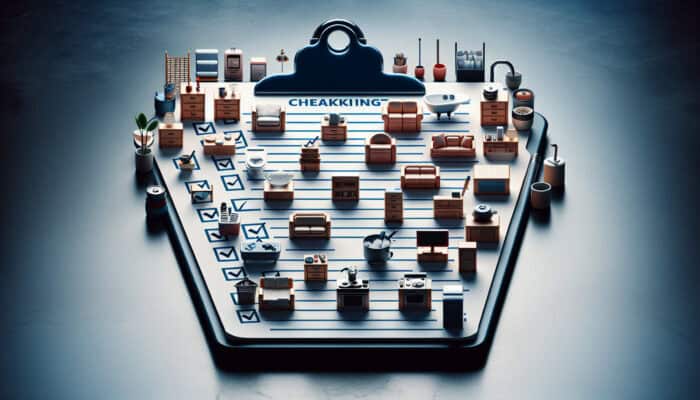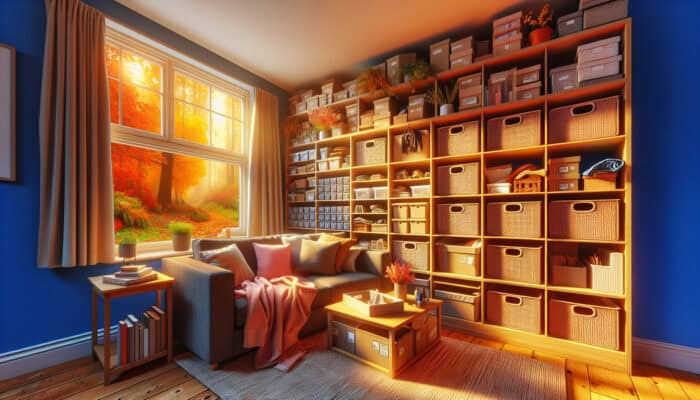Start with a Plan
Create a Room-by-Room Checklist

How to Clear a Small UK Home Easily: Creating a detailed, room-by-room checklist is essential when clearing your home. This approach allows you to address each area, ensuring nothing is overlooked systematically. Begin by listing all rooms in your home, including bedrooms, bathrooms, living areas, and kitchens. For each room, include a bullet list of essential items to check, including furniture, appliances, and personal belongings. This checklist will serve as a practical guide and keep you focused.
- Assess furniture and storage solutions.
- Review clothing and seasonal items.
- Check for unused appliances or kitchenware
- Examine books, decor, and personal items
- Look for expired food and cleaning products
Having this checklist in place helps to minimise distractions and provides a sense of accomplishment as you check off completed tasks. Make sure the checklist stays visible, perhaps on a clipboard or pinned to a wall, so you can easily track your progress.
Set Clear Goals
Defining clear goals is critical to the success of your clearing project. Goals should be specific, measurable, and realistic, allowing you to assess your progress as you go. Examples of goals might include decluttering a specific room, organising a particular area, or reducing the overall volume of items in your home. By setting tangible objectives, you’ll maintain motivation and have a clearer vision of what you want to achieve.
- Declutter and donate at least three bags of unwanted items
- Organise all kitchen cupboards and drawers
- Reduce wardrobe contents by 30%
- Create a functional workspace at home
- Maximise storage in the living room
Consider documenting your goals in a journal or digital format, as this will help reinforce your commitment. Revisiting your goals regularly can also serve as a motivational tool, reminding you of the benefits of a decluttered space.
Allocate Time Wisely
Effective time management is vital in the clearing process. Allocate specific blocks of time for each area of your home, taking into account how long tasks might realistically take. You might find it helpful to break down larger tasks into smaller, more manageable chunks, allowing for breaks in between. This strategy prevents burnout and keeps your energy levels high throughout the process.
When planning your schedule, take into account other commitments, such as work or family responsibilities. For example, you may decide to dedicate weekends to more intensive sessions in larger areas, such as the living room, while weekday evenings can be reserved for smaller spaces, such as bedrooms.
Prioritise Tasks

Understanding which tasks are most urgent or important is essential for managing your time and resources effectively. Identify areas that are particularly cluttered or that hinder your everyday activities, such as the entrance hallway or kitchen counters. Begin with these spaces to create an immediate sense of accomplishment.
Write down your priorities in order of importance. This prioritisation can also help you focus on decluttering items that are easy to let go of initially, building momentum for larger, more challenging decisions later on. Completing these urgent tasks first can drastically improve your living environment and motivate you to continue.
Expert Insights on How to Clear a Small UK Home Easily
What Are the Best Methods for Decluttering?
Several effective decluttering methods are particularly well-suited for small UK homes. One popular technique is the KonMari Method, developed by Marie Kondo. This involves decluttering by category rather than by room. Start with clothing, then move on to books, papers, komono (miscellaneous items), and finally, sentimental items. This method encourages you to ask whether each item “sparks joy,” helping you decide what to keep.
Another effective approach is the Four-Box Method, which uses four boxes labelled “Keep,” “Donate,” “Sell,” and “Trash.” As you sort through your belongings, place each item into one of the boxes. This method simplifies the decision-making process and encourages prompt disposal of unwanted items.
Real-world examples include families who have tackled their clutter using these methods, sharing stories of how they transformed their homes into more functional spaces. For instance, a couple in London reported that using the KonMari Method not only made their home more organised but also significantly improved their overall mood and well-being.
How Can You Maintain a Clutter-Free Home?

Maintaining a clutter-free home requires ongoing effort and the establishment of practical routines. Begin by adopting the one-in, one-out rule: whenever you bring a new item into your home, make it a point to remove an existing one. This practice helps prevent accumulation and encourages mindful consumption.
Developing daily habits is essential for ongoing maintenance. Simple tasks such as tidying surfaces at the end of each day, doing a quick clean-up after meals, and regularly reassessing storage solutions can all contribute to a clutter-free environment. Consider scheduling a monthly decluttering session where you reassess belongings and identify items that may no longer serve a purpose.
Incorporating storage solutions that work for your lifestyle also plays a significant role in maintaining an organised space. Using baskets for toys, drawer dividers for utensils, and under-bed storage for seasonal items can help keep your living area tidy and functional.
What Tools Do Professionals Recommend?
Professionals in home organisation often recommend a selection of effective tools to aid in the decluttering process. Firstly, investing in quality storage bins or boxes can help you categorise items effectively. Look for clear containers that let you see the contents easily, preventing unnecessary rummaging when searching for items.
Label makers are another invaluable tool for maintaining organisation. By clearly labelling boxes, shelves, and storage areas, you can ensure that everything has a designated place, making it easier to return items after use.
Consider also utilising vacuum storage bags for clothing or bedding that you don’t use seasonally. These bags can significantly reduce the space taken up by bulkier items, freeing up valuable storage space in wardrobes or under beds.
Expert analysis indicates that the right tools can drastically improve your efficiency during the clearing-out process, making it easier to maintain an organised home in the long run.
How Can You Maximise Space in a Small UK Home?
Maximising space in a small UK home often involves clever storage solutions and innovative layout adjustments. One effective strategy is to use vertical space. Invest in tall shelving units or wall-mounted storage that draws the eye upward, creating the illusion of a larger space while providing additional storage.
Another solution is multifunctional furniture. Items such as ottomans with hidden storage, sofa beds, or coffee tables with drawers can serve multiple purposes, eliminating the need for additional furniture and freeing up floor space.
Consider rearranging existing furniture to create a more open flow within each room. For example, pulling furniture away from walls and creating conversation areas can make a small living room feel more spacious.
Expert advice suggests regularly reassessing your layout and storage solutions, particularly as your needs change over time. Innovative storage ideas, such as under-stair cupboards or built-in wardrobes, can further enhance your home’s functionality.
What Are the Psychological Benefits of a Clutter-Free Home?
Living in a clutter-free environment has significant psychological advantages. Experts agree that a tidy home can lead to reduced stress and improved mental clarity. Decluttering is often cathartic, providing a sense of control and accomplishment.
Research has shown that disorganised spaces can lead to feelings of anxiety and overwhelm. Conversely, organised environments can foster creativity and enhance focus. A clean space encourages a clearer mind and allows for better decision-making.
To maintain mental clarity, consider implementing strategies to avoid accumulating clutter again, such as establishing regular cleaning routines and adopting minimalism principles. These practices will not only help keep your space clear but also enhance your overall mental well-being.
Sort and Categorise Your Belongings
How Do You Decide What to Keep?
Deciding what to keep during the decluttering process can be challenging yet rewarding. Start by assessing the value and necessity of each item you come across. Consider whether the item is essential to your daily life or has sentimental value that justifies keeping it.
One effective approach is to ask yourself a series of questions about each item. Does it serve a practical purpose? Have you used it in the past year? Does it bring you joy? If the answer is consistently no, it may be time to let it go. It’s essential to be honest with yourself during this process, as holding onto items out of guilt or obligation can lead to further clutter.
Incorporate strategies to handle sentimental items. Consider taking photographs of such items before donating or discarding them, so you can preserve the memories without the physical space they occupy. This approach can ease the emotional burden of letting go while still honouring the memories associated with those items.
Use Categories to Organise
Organising your belongings into categories makes the sorting process more efficient and systematic. By grouping similar items, you can easily identify what you have, making it easier to decide what to keep and what to discard. For example, create separate categories for clothing, kitchenware, books, and decor items.
This method not only streamlines the decluttering process but also allows you to visualise the volume of items within each category. You may be surprised to discover how many duplicates or unused items you have when they are grouped.
Consider using bins or boxes to facilitate this categorisation. Label each container clearly so that you can quickly identify contents when it’s time to look for specific items. This categorisation can extend beyond decluttering and into your ongoing organisational system, making it easier to maintain a tidy home environment.
Label and Store Efficiently
Efficient labelling and storage are crucial to keeping your home organised after decluttering. Using clear labels on storage containers makes it easy to find items when needed. A well-organised label system saves time and frustration, reducing the likelihood that you’ll revert to cluttered spaces.
Choose storage solutions that suit your lifestyle. For frequently used items, opt for open shelving or clear bins for easy access and visibility. On the other hand, less commonly used items can be stored in opaque boxes or containers clearly labelled.
Logically arrange storage and group similar items. For instance, keep all baking supplies in one area of the kitchen and all cleaning supplies in another. This strategic organisation will help streamline your routines and maintain a clutter-free environment.
Create a Sorting System
Establishing a systematic method for sorting your belongings can simplify decision-making and enhance organisational efficiency. One effective approach is to sort items by frequency of use. For example, items you use daily should be easily accessible, while seasonal items can be stored away.
Consider using a tiered sorting system, categorising items into “daily use,” “weekly use,” and “infrequent use.” This method helps prioritise what should remain accessible and what can be stored away.
A consistent sorting system not only helps declutter but also makes it easier to maintain order in your space. Regularly reviewing these categories will help you adapt your storage solutions as your needs change, ensuring that you always have a functional, organised home.
Regularly Review and Update
Periodic reassessment of your belongings is essential to maintaining a clutter-free environment. As life changes, so do your needs and preferences; therefore, regular reviews help ensure that your stored items still align with your current lifestyle.
Set a schedule for these reviews, such as every six months or at the change of seasons. During these assessments, evaluate each item against your current needs. If something no longer serves a purpose or brings joy, decide to donate, sell, or dispose of it.
Incorporate this practice into your routine to avoid the accumulation of unwanted items. This proactive approach ensures your home remains a functional and pleasant space that reflects your evolving lifestyle and preferences.
Dispose of Unwanted Items Responsibly
Where Can You Donate Items in the UK?
Donating unwanted items is a responsible way to declutter and positively impact your community. The UK has numerous charities and organisations that accept a wide range of items. Popular places to donate include local branches of Oxfam, the British Red Cross, and Help the Homeless. Many of these organisations have specific requirements, so it’s wise to check their websites for details on what they accept.
Additionally, some charities even offer collection services, making the donation process more convenient. Look into local community centres or food banks as well, as they often welcome donations of clothing, household items, and non-perishable food.
When donating, ensure that items are clean and in good condition. This helps maintain the quality of items available for those in need and supports the charitable mission of these organisations.
How to Recycle Different Materials?
Understanding local recycling guidelines is essential for the responsible disposal of unwanted items. Each area in the UK may have different rules regarding what can be recycled and how to do it. Generally, common recyclable materials include paper, cardboard, glass, metal, and certain plastics.
To help streamline your recycling efforts, consider the following common materials and their recycling methods:
- Paper and cardboard: Place in your local paper recycling bin or kerbside collection.
- Glass: Recycle via bottle banks or designated glass recycling containers.
- Metal: Most councils accept aluminium cans; check local guidelines for other metals.
- Plastics: Look for recycling symbols; many councils accept specific types.
- Electronics: Use designated e-waste recycling points or charity shops that accept electrical items.
Avoid contaminating recycling bins with non-recyclables, as this can result in the entire bin being rejected. Always check your local council’s website for specific recycling guidelines in your area.
Sell or Give Away What You Can
Selling or giving away items is an excellent way to declutter while potentially earning some extra cash. There are various online platforms and local marketplaces, such as eBay, Facebook Marketplace, and Gumtree, where you can list items for sale.
Alternatively, consider organising a local community swap or a car boot sale to give away or exchange items with neighbours. This approach not only helps you declutter but also fosters a sense of community and sustainability.
When selling items, provide clear descriptions and quality photographs to attract potential buyers. Be realistic about pricing, especially if the items are second-hand. When giving away items, consider posting in online community groups to reach those who may be in need.
Research-Backed Benefits of How to Clear a Small UK Home Easily
How Does a Clutter-Free Home Affect Mental Health?
A clutter-free home has been associated with numerous mental health benefits. Studies indicate that living in an organised environment can significantly reduce stress levels and improve overall well-being. This is particularly relevant in the UK, where urban living can often contribute to feelings of anxiety and overwhelm.
Real-world examples illustrate the psychological transformations people experience post-decluttering. Many individuals report feeling a greater sense of calm and clarity in their lives once their spaces are organised. This newfound order can lead to improved focus and greater productivity in daily tasks.
Incorporating decluttering into your routine can be a form of self-care. Simplifying your environment creates a sanctuary that promotes relaxation and mental clarity, making it easier to navigate life’s challenges.
What Are the Physical Health Benefits?
The physical health benefits of a clean home are equally important. Reducing clutter not only contributes to better air quality but can also decrease allergens and other irritants commonly found in dust and clutter. A thorough decluttering and cleaning process can improve respiratory health, particularly in small UK homes where space can be confined.
Organised spaces also encourage a more active lifestyle. Homes free of obstacles promote movement and activity, whether through routine tasks like cleaning or engaging in hobbies that require physical effort.
Additionally, having a clean kitchen can lead to healthier eating habits, as you’re more likely to prepare meals in an organised environment. The mental clarity achieved through decluttering can also motivate healthier choices overall, fostering a more holistic approach to well-being.
Can Decluttering Boost Productivity?
Research suggests that a clutter-free environment can significantly enhance productivity. An organised space reduces distractions, making it easier to concentrate on the tasks at hand. Studies have shown that individuals working in tidy environments can focus better and complete tasks more efficiently.
To maintain a productive space, establish specific zones for work, relaxation, and other activities. Keep these areas clutter-free to enhance focus and creative thinking. Implementing organisational systems, such as clear filing for paperwork and designated spots for essential items, supports ongoing productivity.
Incorporating regular decluttering sessions into your routine will help maintain this productivity-boosting environment. As you sort through items, establish a habit of evaluating whether they contribute positively to your workspace or overall productivity.
Clean and Refresh Your Space
What Cleaning Products Work Best?
Selecting the right cleaning products is essential for achieving a thorough clean in your home. In UK homes, there is a wide range of effective cleaning solutions, from traditional cleaning supplies to eco-friendly options. For general cleaning, multipurpose cleaners can save time and effort, allowing you to tackle various surfaces with one product.
Consider incorporating natural cleaning solutions, such as vinegar and baking soda, which are effective at cutting through grime and odours without harsh chemicals. Using essential oils can also add a pleasant fragrance to your cleaning routine, enhancing the overall atmosphere of your home.
When choosing cleaning products, be mindful of any allergies or sensitivities you or your family members may have. Always read labels carefully and opt for products that are safe for your specific needs, especially if you have children or pets in the home.
Deep Clean Key Areas
Deep cleaning specific areas of your home is crucial for long-term cleanliness. Focus on spaces that accumulate the most dirt and grime, such as kitchens and bathrooms. These areas require regular attention to prevent the buildup of bacteria and allergens.
Create a checklist of deep-cleaning tasks for key areas, which may include:
- Scrubbing kitchen appliances, including ovens and microwaves
- Cleaning out kitchen cupboards and wiping down shelves
- Deep cleaning bathroom tiles and grout
- Sanitising sinks and toilets thoroughly
- Washing curtains and cleaning windows
Incorporating these tasks into your cleaning routine ensures that your home remains a healthy and welcoming environment. A thorough deep clean not only improves hygiene but also enhances the overall aesthetic of your space.
Refresh with Simple Decor Changes
Updating your home’s decor can give it a fresh feel without extensive renovations. Small changes can significantly impact the overall aesthetic and atmosphere of your living space. Consider rearranging furniture to create a new focal point or to improve the flow of a room.
Adding new accents such as cushions, throws, or artwork can breathe new life into your home. These elements can introduce colour and texture, making your space feel more inviting.
Consider incorporating plants into your decor, as they not only enhance visual appeal but also improve air quality. Look for easy-to-care-for options such as snake plants or pothos that thrive indoors and require minimal maintenance.
Maintain Your Newly Cleared Home
Establish Daily Cleaning Routines
Developing daily cleaning routines is essential for maintaining a tidy home and preventing clutter from accumulating again. Start small by incorporating simple tasks that can be completed quickly. For instance, make it a habit to wash dishes immediately after meals and wipe down surfaces each evening.
Consider designating specific days for certain tasks, such as laundry on Mondays and vacuuming on Wednesdays. Establishing routines like these not only helps maintain cleanliness but also creates a sense of discipline and structure in your household.
Encourage all family members to participate in daily cleaning tasks to foster a sense of responsibility and teamwork. This collaborative approach makes maintaining a clutter-free environment more manageable and enjoyable for everyone.
How Often Should You Declutter?
Establishing a regular decluttering schedule is crucial for keeping your home manageable. While the frequency may vary by individual lifestyle, setting aside time seasonally or monthly can help you stay on top of unwanted items.
A seasonal decluttering schedule allows for a comprehensive review of belongings, making it easier to identify items that may no longer be needed. Additionally, consider implementing a monthly check-in to reassess your categories and ensure your belongings still align with your lifestyle.
Incorporating decluttering into your annual spring cleaning ritual can also be beneficial, as it provides a natural opportunity to refresh your home and evaluate your possessions. This proactive approach ensures that your home remains an organised and functional space.
What Habits Help Keep a Home Clear?
Adopting specific habits can significantly help maintain a clutter-free environment. Start by establishing a ‘no clutter’ rule, where items must be returned to their designated places immediately after use. This practice prevents the buildup of stray items that can lead to clutter.
Another helpful habit is to reassess incoming items regularly. Whenever you purchase something new, consider what you can remove from your home in exchange. This method encourages mindful consumption and helps maintain balance in your space.
Encourage family members to adopt similar habits, creating a household culture that values organisation and cleanliness. Regularly discussing clutter and its impact can motivate everyone to participate in maintaining a tidy home.
FAQs
How long does it typically take to clear a small home?
The time it takes to clear a small home varies based on the extent of clutter and the number of items. Generally, it can take anywhere from a few days to several weeks, depending on the plan you set.
What should I do with items that are still useful but not needed?
Consider donating items to local charities or selling them online. Platforms like eBay and Facebook Marketplace can help you find new homes for useful items.
How do I handle sentimental items during decluttering?
Evaluate each sentimental item carefully. Consider keeping only those that evoke positive memories, and consider taking photographs of the items you decide to part with instead.
What eco-friendly cleaning products can I use?
Eco-friendly cleaning products include vinegar, baking soda, and lemon juice. These natural cleaners are effective and safe for both your health and the environment.
Can decluttering really improve my mental health?
Yes, research indicates that a clutter-free environment can reduce stress and anxiety, thereby improving clarity and well-being.
How often should I clean my home?
Establish a cleaning routine that suits your needs, with daily tasks for upkeep and deeper cleaning at least once a month to maintain a tidy environment.
What items should I prioritise when decluttering?
Start with areas that are most cluttered or hinder daily life, such as the kitchen or entrance area. Focus on items that are rarely used or bring little joy.
Are there specific donation guidelines I should follow?
Yes, ensure that items are clean and in good condition before donating. Check with charities for specific guidelines on what they accept.
How do I keep my space organised after decluttering?
Implement a systematic organisation system and establish daily habits that prevent clutter from accumulating again, such as the one-in, one-out rule.
What are some good storage solutions for small spaces?
Consider vertical storage, multifunctional furniture, and under-bed storage to maximise space in your home.






